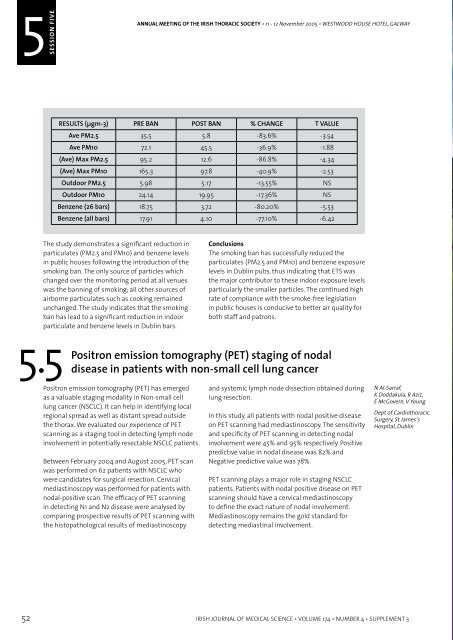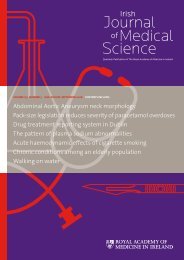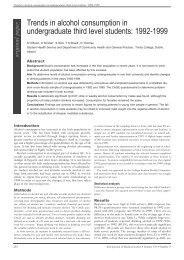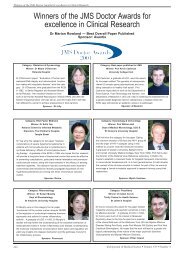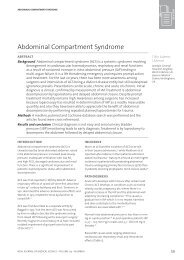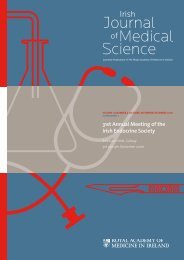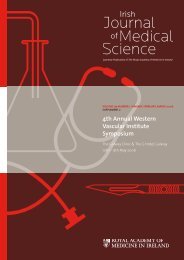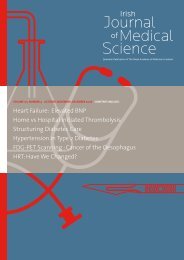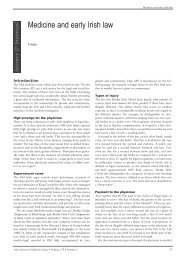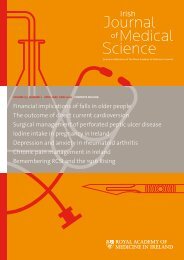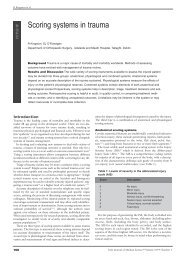Annual General Meeting of the Irish Thoracic Society - IJMS | Irish ...
Annual General Meeting of the Irish Thoracic Society - IJMS | Irish ...
Annual General Meeting of the Irish Thoracic Society - IJMS | Irish ...
Create successful ePaper yourself
Turn your PDF publications into a flip-book with our unique Google optimized e-Paper software.
51<br />
SESSION<br />
SESSION FIVE ONE<br />
ANNUAL MEETING OF THE IRISH THORACIC SOCIETY • 11 - 12 November 2005 • WESTWOOD HOUSE HOTEL, GALWAY<br />
RESULTS (µgm-3) PRE BAN POST BAN % CHANGE T VALUE<br />
Ave PM2.5 35.5 5.8 -83.6% -3.54<br />
Ave PM10 72.1 45.5 -36.9% -1.88<br />
(Ave) Max PM2.5 95.2 12.6 -86.8% -4.34<br />
(Ave) Max PM10 165.3 97.8 -40.9% -2.53<br />
Outdoor PM2.5 5.98 5.17 -13.55% NS<br />
Outdoor PM10 24.14 19.95 -17.36% NS<br />
Benzene (26 bars) 18.75 3.72 -80.20% -5.53<br />
Benzene (all bars) 17.91 4.10 -77.10% -6.42<br />
The study demonstrates a significant reduction in<br />
particulates (PM2.5 and PM10) and benzene levels<br />
in public houses following <strong>the</strong> introduction <strong>of</strong> <strong>the</strong><br />
smoking ban. The only source <strong>of</strong> particles which<br />
changed over <strong>the</strong> monitoring period at all venues<br />
was <strong>the</strong> banning <strong>of</strong> smoking; all o<strong>the</strong>r sources <strong>of</strong><br />
airborne particulates such as cooking remained<br />
unchanged. The study indicates that <strong>the</strong> smoking<br />
ban has lead to a significant reduction in indoor<br />
particulate and benzene levels in Dublin bars.<br />
Conclusions<br />
The smoking ban has successfully reduced <strong>the</strong><br />
particulates (PM2.5 and PM10) and benzene exposure<br />
levels in Dublin pubs, thus indicating that ETS was<br />
<strong>the</strong> major contributor to <strong>the</strong>se indoor exposure levels<br />
particularly <strong>the</strong> smaller particles. The continued high<br />
rate <strong>of</strong> compliance with <strong>the</strong> smoke-free legislation<br />
in public houses is conducive to better air quality for<br />
both staff and patrons.<br />
5.5<br />
Positron emission tomography (PET) staging <strong>of</strong> nodal<br />
disease in patients with non-small cell lung cancer<br />
Positron emission tomography (PET) has emerged<br />
as a valuable staging modality in Non-small cell<br />
lung cancer (NSCLC). It can help in identifying local<br />
regional spread as well as distant spread outside<br />
<strong>the</strong> thorax. We evaluated our experience <strong>of</strong> PET<br />
scanning as a staging tool in detecting lymph node<br />
involvement in potentially resectable NSCLC patients.<br />
Between February 2004 and August 2005, PET scan<br />
was performed on 62 patients with NSCLC who<br />
were candidates for surgical resection. Cervical<br />
mediastinoscopy was performed for patients with<br />
nodal-positive scan. The efficacy <strong>of</strong> PET scanning<br />
in detecting N1 and N2 disease were analysed by<br />
comparing prospective results <strong>of</strong> PET scanning with<br />
<strong>the</strong> histopathological results <strong>of</strong> mediastinoscopy<br />
and systemic lymph node dissection obtained during<br />
lung resection.<br />
In this study, all patients with nodal positive disease<br />
on PET scanning had mediastinoscopy. The sensitivity<br />
and specificity <strong>of</strong> PET scanning in detecting nodal<br />
involvement were 45% and 95% respectively. Positive<br />
predictive value in nodal disease was 82% and<br />
Negative predictive value was 78%.<br />
PET scanning plays a major role in staging NSCLC<br />
patients. Patients with nodal positive disease on PET<br />
scanning should have a cervical mediastinoscopy<br />
to define <strong>the</strong> exact nature <strong>of</strong> nodal involvement.<br />
Mediastinoscopy remains <strong>the</strong> gold standard for<br />
detecting mediastinal involvement.<br />
N Al-Sarraf,<br />
K Doddakula, R Aziz,<br />
E McGovern, V Young<br />
Dept <strong>of</strong> Cardiothoracic<br />
Surgery, St James’s<br />
Hospital, Dublin<br />
52 IRISH JOURNAL OF MEDICAL SCIENCE • VOLUME 174 • NUMBER 4 • SUPPLEMENT 3


